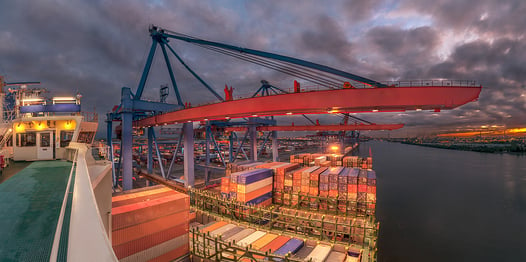As the negotiations between the West Coast ports and longshoremen dragged on in 2022 and 2023, some companies began redirecting import freight into the East Coast. Since then, however, the ink has been dry for quite a while on a new multi-year West Coast port contract, and there are now negotiations on the East Coast that are causing trepidation among importers. In this article, we’ll look at potential ramifications for East Coast imports and tell you what you can do to avoid disruption to your supply chain.
Background: imports head East
 On the West Coast, the previous labor agreement between the International Longshore and Warehouse Union (ILWU) and the Pacific Maritime Association (PMA) expired on July 1, 2022. In early 2023, the two sides appeared to be miles apart, with the biggest points of contention being wages and automation at the terminals.
On the West Coast, the previous labor agreement between the International Longshore and Warehouse Union (ILWU) and the Pacific Maritime Association (PMA) expired on July 1, 2022. In early 2023, the two sides appeared to be miles apart, with the biggest points of contention being wages and automation at the terminals.
During these labor contract negotiations, many shippers began to divert cargo away from West Coast ports. Some estimates have the number at over 1 million twenty-foot equivalent units (TEU) that moved to East Coast ports. Much of this has been “discretionary cargo” containing products that don’t need to be shipped into a particular port due to timing or geographic constraints. As such, port choice is flexible.
Finally, the two sides reached an agreement on June 14, 2023. The new labor contract is a 6-year deal covering all 29 ports on the US West Coast. The 6 years is notable as, historically, most of the contracts between the ILWU and PMA have been 4-year agreements. Also notable is the 32% pay increase that the ILWU obtained for its workers over the 6-year span.
Now: East Coast imports at risk
The current contract between the East and Gulf Coast ports and the International Longshoremen’s Association – which represents 45,000 workers – is set to expire on September 30, 2024. According to Inside Logistics, the ILA is telling its members to prepare to strike on October 1, 2024. The union vows to remain firm regarding the date and will not extend the current contract beyond it.
With the 32% increase secured by West Coast workers over the life of their contract setting a benchmark, the ILA is likely to push for similar terms. This could lead to contentious negotiations, especially as the contract's end date approaches.
What can shippers do?
According to Weber Logistics VP of Transportation, Gary Kendle, there are several things that you can do to mitigate potential disruptions to your East Coast freight.
- Stay Informed: Regularly engage with your 3PL provider and stay updated on the latest developments in negotiations. Establish open lines of communication to ensure a flow of real-time information, enabling you to make informed decisions based on the evolving situation.
- Strategic Planning: Strategic planning is crucial. Initiate discussions with logistics partners well in advance to plan for potential shifts in cargo volume. Consider various scenarios and devise agile logistics strategies to adapt to changing circumstances.
- Consider the West Coast: While East Coast importing may be the current preference for some businesses, it's prudent to consider the import advantages of the West Coast – especially the ability to get Asia-made products into distribution quickly. Assess the flexibility of your supply chain and be prepared to pivot if negotiations on the East Coast become protracted, impacting the efficiency of your logistics operations.
- Chassis and Drayage: Monitor chassis availability and drayage issues closely. If there's a significant shift in cargo volume, it could impact these critical aspects of the supply chain. Strategic planning is advised to mitigate potential disruptions.
- Act Early: Proactivity is key. Don't wait until the last minute to address potential challenges. Initiate discussions with your logistics partners early on, preferably after settling ocean contracts and well before any potential disruptions occur. This foresight will allow for more effective contingency planning.
Turn to Weber Logistics to navigate supply chain challenges
As the East Coast prepares for these critical negotiations, businesses must remain vigilant, informed, and prepared for potential shifts in the supply chain landscape. The key is to stay ahead of the curve, adapt strategically, and work closely with logistics partners that are agile enough to navigate the challenges ahead.
Weber Logistics can help you do all of the above. Our robust logistics facilities can handle high velocity, high capacity transloading to OTR on demand, while our trucking services can provide OTR transport coast to coast as part of an integrated, turnkey logistics solution. To learn more about our integrated supply chain solutions, contact us today.




 Capital Management
Capital Management